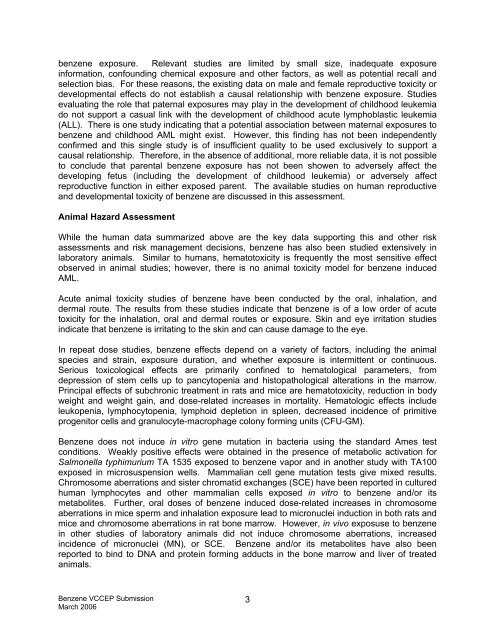(VCCEP) Tier 1 Pilot Submission for BENZENE - Tera
(VCCEP) Tier 1 Pilot Submission for BENZENE - Tera
(VCCEP) Tier 1 Pilot Submission for BENZENE - Tera
Create successful ePaper yourself
Turn your PDF publications into a flip-book with our unique Google optimized e-Paper software.
enzene exposure. Relevant studies are limited by small size, inadequate exposure<br />
in<strong>for</strong>mation, confounding chemical exposure and other factors, as well as potential recall and<br />
selection bias. For these reasons, the existing data on male and female reproductive toxicity or<br />
developmental effects do not establish a causal relationship with benzene exposure. Studies<br />
evaluating the role that paternal exposures may play in the development of childhood leukemia<br />
do not support a casual link with the development of childhood acute lymphoblastic leukemia<br />
(ALL). There is one study indicating that a potential association between maternal exposures to<br />
benzene and childhood AML might exist. However, this finding has not been independently<br />
confirmed and this single study is of insufficient quality to be used exclusively to support a<br />
causal relationship. There<strong>for</strong>e, in the absence of additional, more reliable data, it is not possible<br />
to conclude that parental benzene exposure has not been showen to adversely affect the<br />
developing fetus (including the development of childhood leukemia) or adversely affect<br />
reproductive function in either exposed parent. The available studies on human reproductive<br />
and developmental toxicity of benzene are discussed in this assessment.<br />
Animal Hazard Assessment<br />
While the human data summarized above are the key data supporting this and other risk<br />
assessments and risk management decisions, benzene has also been studied extensively in<br />
laboratory animals. Similar to humans, hematotoxicity is frequently the most sensitive effect<br />
observed in animal studies; however, there is no animal toxicity model <strong>for</strong> benzene induced<br />
AML.<br />
Acute animal toxicity studies of benzene have been conducted by the oral, inhalation, and<br />
dermal route. The results from these studies indicate that benzene is of a low order of acute<br />
toxicity <strong>for</strong> the inhalation, oral and dermal routes or exposure. Skin and eye irritation studies<br />
indicate that benzene is irritating to the skin and can cause damage to the eye.<br />
In repeat dose studies, benzene effects depend on a variety of factors, including the animal<br />
species and strain, exposure duration, and whether exposure is intermittent or continuous.<br />
Serious toxicological effects are primarily confined to hematological parameters, from<br />
depression of stem cells up to pancytopenia and histopathological alterations in the marrow.<br />
Principal effects of subchronic treatment in rats and mice are hematotoxicity, reduction in body<br />
weight and weight gain, and dose-related increases in mortality. Hematologic effects include<br />
leukopenia, lymphocytopenia, lymphoid depletion in spleen, decreased incidence of primitive<br />
progenitor cells and granulocyte-macrophage colony <strong>for</strong>ming units (CFU-GM).<br />
Benzene does not induce in vitro gene mutation in bacteria using the standard Ames test<br />
conditions. Weakly positive effects were obtained in the presence of metabolic activation <strong>for</strong><br />
Salmonella typhimurium TA 1535 exposed to benzene vapor and in another study with TA100<br />
exposed in microsuspension wells. Mammalian cell gene mutation tests give mixed results.<br />
Chromosome aberrations and sister chromatid exchanges (SCE) have been reported in cultured<br />
human lymphocytes and other mammalian cells exposed in vitro to benzene and/or its<br />
metabolites. Further, oral doses of benzene induced dose-related increases in chromosome<br />
aberrations in mice sperm and inhalation exposure lead to micronuclei induction in both rats and<br />
mice and chromosome aberrations in rat bone marrow. However, in vivo exposuse to benzene<br />
in other studies of laboratory animals did not induce chromosome aberrations, increased<br />
incidence of micronuclei (MN), or SCE. Benzene and/or its metabolites have also been<br />
reported to bind to DNA and protein <strong>for</strong>ming adducts in the bone marrow and liver of treated<br />
animals.<br />
Benzene <strong>VCCEP</strong> <strong>Submission</strong><br />
March 2006<br />
3





